Mount Zion
After Jerusalem expanded to include a higher hill to its west, the prophets continued to use the name Zion as a synonym for Jerusalem, e.g. Isaiah: "For out of Jerusalem a remnant will go out, and out of Mount Zion those who shall escape." (2 Kings 19:31.)
However, in the Byzantine period (if not earlier), the term came to mean just the western hill. The reason has to do with the way people read the following verses from Micah (3:12):
Therefore Zion for your sake will be plowed like a field,
and Jerusalem will become heaps of rubble,
and the mountain of the temple like the high places of a forest.
Often the prophets say the same thing consecutively in different ways (a stylistic usage known as parallelism), but a pilgrim from Bordeaux (333 AD: our earliest Christian source describing the holy places) speaks of coming "out of Jerusalem to go up Mount Zion," with the pool of Siloam on the left. A few lines later the pilgrim cites the text from Micah. He appears to have understood it as follows: Jerusalem is the whole thing. We know that the mountain of the temple was the eastern hill. Zion must refer, therefore, to Jerusalem's other, western hill. O'ConnorMurphy-O'Connor, Jerome. The Holy Land: An Archaeological Guide, 4th edition. London: Oxford, 1998. suggests that on the basis of such interpretations, the application of the name contracted to the western hill.
Although outside the present Old City wall, the part of the western hill that we today call Mt. Zion was inside the wall in Jesus' time:
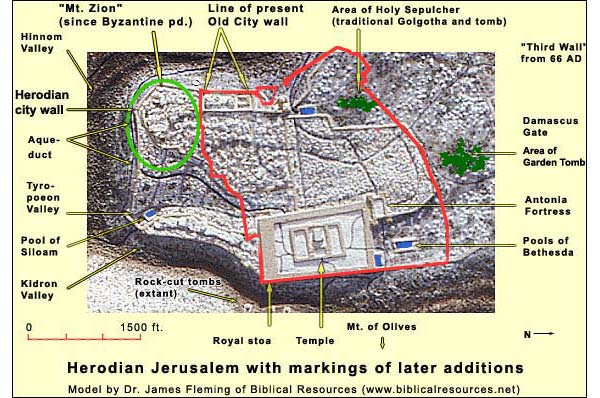
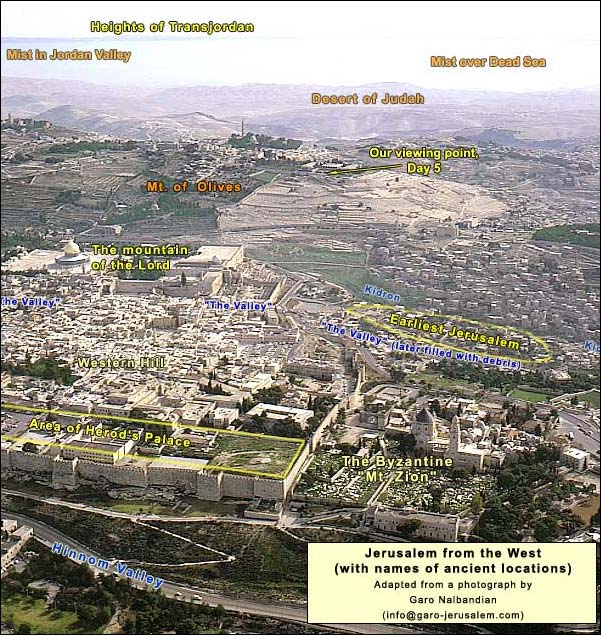
{mospagebreak title=The Upper Room } The Upper Room During the three pilgrimage festivals (Passover, Pentecost and Tabernacles), Jews flocked to Jerusalem. No one knows how many: even today, with aerial photography, it is hard to estimate the size of a crowd. Few accept Josephus'Josephus Flavius (36 – 100 AD), Jewish general, one of two directing the revolt against Rome in Galilee. After Vespasian captured him, he prophesied the latter would be emperor. When this proved true, the Romans honored him. He then turned historian, writing The Jewish War, The Antiquities of the Jews and many other books. Because of a paragraph about John the Baptist (and maybe a sentence about Jesus), the Church preserved his works. figure of 2,700,000 at one Passover (WarWar= Josephus Flavius. The Jewish War. Translated by William Whiston. (Abbreviated in text as War.) VI 9.3). The esplanades of the al-Aqsa Mosque and the Dome of the Rock, which most scholars identify with the courts of Herod's Temple, can hold 400,000. That figure is probably close to the ancient reality. But whether one chooses the larger or smaller number, it is clear that during these festivals Jerusalem experienced a huge "tourism boom." Where would all the pilgrims have stayed? Many would have received hospitality in the homes of Jerusalemites, who made guest rooms available for this purpose. Homeowners were prohibited from taking rent from pilgrims because the homes in Jerusalem "belong to the tribes," although the pilgrims would have felt a social obligation (not legally binding) to give gifts in return. More. (Those who could not find accommodation in the city would have stayed in tents outside, as Josephus indicates in AntiquitiesAntiquities = Josephus Flavius. Antiquities of the Jews. Translated by William Whiston. (Abbreviated in text as Antiquities.) XVII 9.3.)
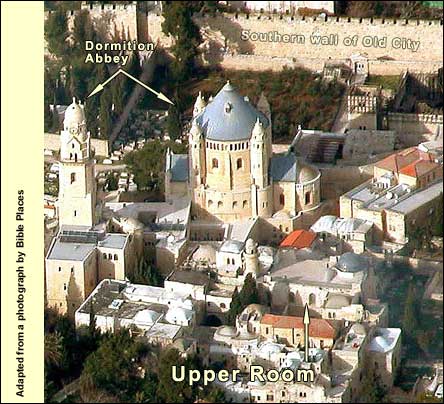
During Jesus' pilgrimage to Jerusalem at Passover, he made use of such a guest room. In Luke 22:10-12, Jesus tells Peter and John to follow a man carrying a jar of water, and when he enters a house, to tell the owner, "The Teacher says to you, 'Where is the guest room, where I may eat the Passover with my disciples?' cj(22,12); He will show you a large, furnished upper room. Make preparations there." Such a room is also mentioned in Acts 1:12. After Jesus' ascension from the Mt. of Olives, the disciples went back into the city, to "the upper room where they were staying." They were still in Jerusalem fifty days after Passover for the Feast of Weeks (or Pentecost, seven weeks after Passover, on the 50th day). At this time they were ... ...all with one accord in one place. cb(2,2); Suddenly there came from the sky a sound like the rushing of a mighty wind, and it filled all the house where they were sitting. cb(2,3); Tongues like fire appeared and were distributed to them, and one sat on each of them. cb(2,4); They were all filled with the Holy Spirit, and began to speak with other languages, as the Spirit gave them the ability to speak. cb(2,5); (Acts 2:1-4) Both these events relate to the history of ancient Israel. The Lord's Supper: According to the first three ("synoptic") Gospels, this meal was a Passover Seder. And what was Passover at that time? The festival had both an agricultural and a historical significance. (As did the Feast of TabernaclesThe Feast of Tabernacles marked the autumn harvest (of figs, dates, olives, pomegranates and grapes), when people lives in booths to guard the ripe fruits from thieves and thirsty animals. Leviticus 23:42 also gave the festival historical significance: "You shall dwell in booths seven days. All who are native-born in Israel shall dwell in booths, that your generations may know that I made the children of Israel to dwell in booths, when I brought them out of the land of Egypt. I am Yahweh your God.".) Agriculturally, Passover marked the barley harvest. Historically, the Book of Exodus (12:14) calls it a festival of remembrance, on which the children of Israel remember how God delivered them from slavery in Egypt. Jesus broke bread, in our earliest account (I Corinthians 11:24-25), saying, “Take, eat. This is my body, which is broken for you. Do this in memory of me.” cb(11,25); In the same way he also took the cup, after supper, saying, “This cup is the new covenant in my blood. Do this, as often as you drink, in memory of me.” cb(11,26); He presents himself as the fulfillment of the redemption that began with the exodus from Egypt. The Feast of Weeks or Pentecost corresponds to the wheat harvest, but the First Testament does not connect it to a historical event. The ancient Rabbis did so, however, linking it to the giving of the Torah at Mt. Sinai. Here, then, we also find a fulfillment: the giving of the Holy Spirit occurs on the anniversary of the giving of the Torah.
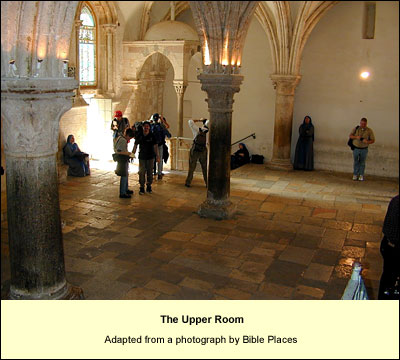
The Upper Room that we visit today on Mt. Zion has no resemblance to a room of 2000 years ago. The area has gone through a difficult history. The present design is basically Franciscan, from the 14th century - but with a Muslim mihrabMihrab: a niche or depression in a wall, e.g. of a mosque, indicating the kibla: the direction toward Mecca, for the purpose of Muslim prayer., added in the 16th after an Ottoman sultan ordered the "infidels" out. (The Israelis took over in 1948 and have held the hill ever since. The site is under their jurisdiction.) Is this, despite the Gothic appearance, the place of the events that we remember here? The case is stronger for Pentecost. Writing in the 4th century, Bishop Epiphanius of Salamis describes a visit by HadrianPublius Aelius Hadrianus (76 – 138 AD). Roman emperor from 117 until his death. He quelled the Bar Kokhba revolt, the second major Jewish uprising in the land. After banishing the Jews from Jerusalem, he rebuilt the city, naming it Aelia Capitolina. He is also remembered as the builder of Hadrian's Wall in northern England. to Jerusalem more than 200 years before his time. The emperor, he says, surveyed the city, which still lay in ruins from the destruction by Titus in 70 AD. And Hadrian found the temple of God trodden down and the whole city devastated, save for a few houses and the very small church of God, where the disciples, when they had returned after the Savior had ascended from the Mount of Olives, went to the upper room. For there it had been built, that is, in that portion of Zion that escaped destruction, together with blocks of houses in the neighborhood of Zion and the seven synagogues that alone remained standing in Zion, like solitary huts. (On Weights and Measures, 14-15) By the time Epiphanius wrote, the term "Zion" was confined to Jerusalem's western hill (see Mt. Zion). In 348 one Cyril, later to become bishop of Jerusalem, delivered a sermon referring to the place "where the Pentecost Spirit descended upon the apostles, namely in the Upper Church of the Apostles." Was this the same "small church of God" in Zion referred to by Epiphanius? Apparently so, for later in the 4th century a bishop named John refers to... the dedication of the Holy and Glorious Zion, which is the mother of all churches, that had been founded by the Apostles, which Emperor Theodosius the Great (379-395) has built, enlarged, and glorified, and in which the Holy Spirit had come down on the holy day of Pentecost. (van EsbroeckVan Esbroeck, Michel. Les plus anciens homiliaires Georgiens. Louvain, Belgium: 1975., 314-315.) When EgeriaName uncertain. A nun from the Atlantic coast, perhaps Spain, who visited the Holy Land in the late 4th century and described her journey in Latin for the sisters at home. She had a special interest in churches and Christian ritual. Only the middle of her Travels has survived, but it is a unique and valuable source. describes the Jerusalem liturgy (ca. 394 AD), she mentions that the Sunday morning service is held in the large church built by Constantine in Golgotha (today the Holy Sepulcher - SL), "that is, behind the Cross, on every Lord's Day throughout the year except on the one Sunday of Pentecost, when they proceed to Zion." (My emphasis - SL.) There is a strong tradition, then, at least from the 4th century, maybe from the 2nd, and even perhaps from the time of the event itself, connecting a place on Mt. Zion with the gift of the Holy Spirit on Pentecost. There is no 4th-century tradition, however, connecting the same place with Jesus' Passover meal. According to EgeriaFrom the letters of Egeria, a nun of the 4th-century, describing her pilgrimage to the Holy Land. (The "Anastasis" was the Church of the Resurrection with the empty tomb at its center.) XXXV On the fifth weekday everything that is customary is done from the first cockcrow until morning at the Anastasis, and also at the third and at the sixth hours. But at the eighth hour all the people gather together at the martyrium according to custom, only earlier than on other days, because the dismissal must be made sooner. Then, when the people are gathered together, all that should be done is done, and the oblation is made on that day at the martyrium, the dismissal taking place about the tenth hour. But before the dismissal is made there, the archdeacon raises his voice and says: "Let us all assemble at the first hour of the night in the church which is in Eleona, for great toil awaits us to-day, in this very night." 2. Then, after the dismissal at the martyrium, they arrive behind the Cross, where only one hymn is said and prayer is made, and the bishop offers the oblation there, and all communicate. Nor is the oblation ever offered behind the Cross on any day throughout the year, except on this one day. And after the dismissal there they go to the Anastasis, where prayer is made, the catechumens and the faithful are blessed according to custom, and the dismissal is made., that meal was remembered on Maundy Thursday "behind the Cross" at Constantine's Church of the Resurrection. Thus the 4th-century Christians, despite their interest in identifying biblical sites, did not have a traditional place for the Lord's supper, as they did for Pentecost. Since both events occurred in upper rooms, however, the one on Mt. Zion attracted the memory of the Lord's supper a century later. With one or both of these traditions at their backs, the Byzantines built a grand church called Holy Zion (Hagia Zion), which appears on the 6th-century Madaba map. It is unclear whether it incorporated the older Church of the Apostles.
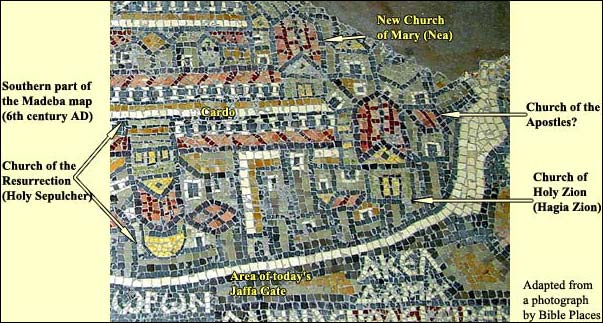
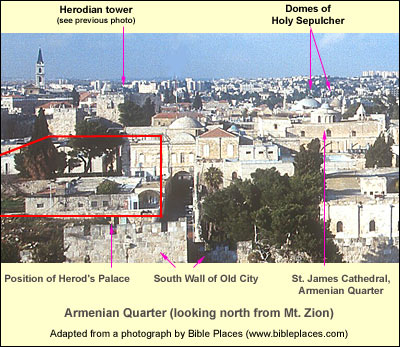
A liturgical celebration in the Church of Holy Zion focused on King David and the Apostle James (founders, respectively, of the Jewish and Christian communities in Jerusalem). This service gave rise to the belief that both were buried on the hill. (O'ConnorMurphy-O'Connor, Jerome. The Holy Land: An Archaeological Guide, 4th edition. London: Oxford, 1998., p. 105.) Accordingly, the traditional tomb of James is today found in the Armenian cathedral just north of the Old City wall. (See St. James Cathedral in the photo on the right.) The tomb of David is located in a chamber below the Upper Room. The Book of Kings (1 Kings 2:10) has David buried within his city, which was on the spur just south of the Temple Mount. But the Byzantines didn't know where David's Jerusalem was. Misled by the name Zion, which had shifted to this western hill, they assumed his grave was here.
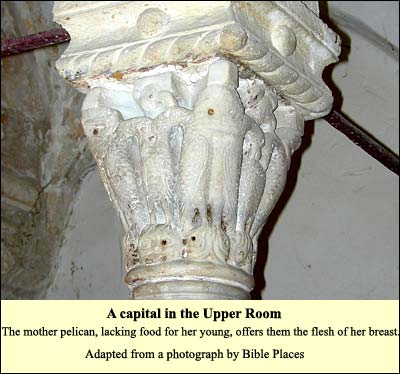
When the Persian army invaded the Byzantine Empire in 614, it destroyed most of the land's churches, including Holy Zion. After the Persian withdrawal, the Christians rebuilt it, but in the early 11th century al-HakimAl-Hakim (996-1021). Fatimid Caliph who ruled the Muslim world from Egypt, waging a relentless campaign to convert his Christian and Jewish subjects to Islam. In 1016, convinced of his own divinity, he led his followers out of Islam into a new religion, whose members are known as Druze. He disappeared in Cairo in 1021. Non-Druze believe he was murdered. Druze believe he went into hiding and will return to redeem and rule the world. battered it down. Within the southern section of the ruins, the Crusaders built a church they called St. Mary of Mt. Zion: they had a tradition that after Jesus' resurrection, the Virgin had lived on this hill until her death (today remembered in the nearby Dormition Abbey). The Crusader church incorporated today's Upper Room (the north wall includes Crusader columns). With implicit reference to the Lord's Supper, a Crusader capital reflects the belief that the pelican, if unable to find food for her young, offers them flesh from her breast. Logistics: Open from 8 a.m. to 5 p.m., but Friday only to 1 p.m. {mospagebreak title=Peter in Gallicantu} St. Peter in Gallicantu: The House of Caiaphas?
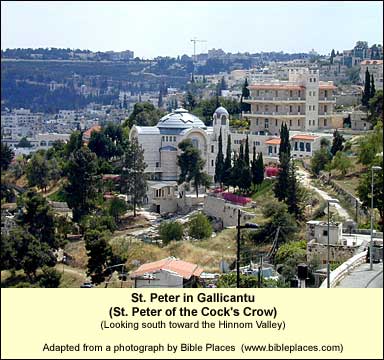
In the 4th century AD, Christians were first allowed to build churches. In some cases they may have had a continuous tradition about a particular place, and then we should expect to find the ruins of a 4th-century church. There were such, for example, at Capernaum, Tabgha, Kursi, Bethlehem, Mamre, on the Mt. of Olives and in Jerusalem. Where the ruins do not go back that far, their absence may indicate that in the obscure centuries, the 1st through the 4th, Christians had no strong tradition connecting an event to the place. At St. Peter in Gallicantu on Mt. Zion, there are 1st-century ruins, but Christians did not build a church here till the 6th. The first literary reference stems from an 8th-century monk (a later Epiphanius): "To the right, outside the city and near the wall, is a church, where Peter, when he went out, bitterly wept." Nevertheless, there are three good reasons to come here: 1. Whether or not this was the site of Caiaphas' house, the place certainly helps one to get the feeling of what it must have been like to be imprisoned overnight. Beneath the church are two intriguing chambers hewn into bedrock. The larger one may have been a storeroom: some of the holes in the stones could have been for hanging sacks of grain. Yet they could also have been for chaining prisoners.
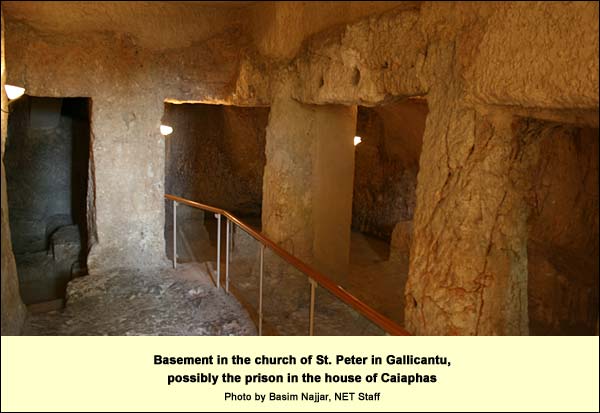
On the south side of this room is a narrow aisle with a single step, on which a guard could stand to look through a small window into a deeper chamber, where a prisoner might be kept. Today we enter this deeper chamber through a recent breach. Standing in it and looking up (as in the photo, right), we see two openings, above which is a divided staircase. No doubt this staircase reached the bottom of the chamber at a time when the floor was higher. Perhaps this was a Jewish ritual bath. It could have been deepened to form a high-security cell. A hole directly above resembles the opening of a cistern. In memory of the night he spent under arrest, we may here read Psalm 88. 2. Outside the church, a few yards to the north, is an ancient stepped street. It may have been here at the time of Jesus' trial.
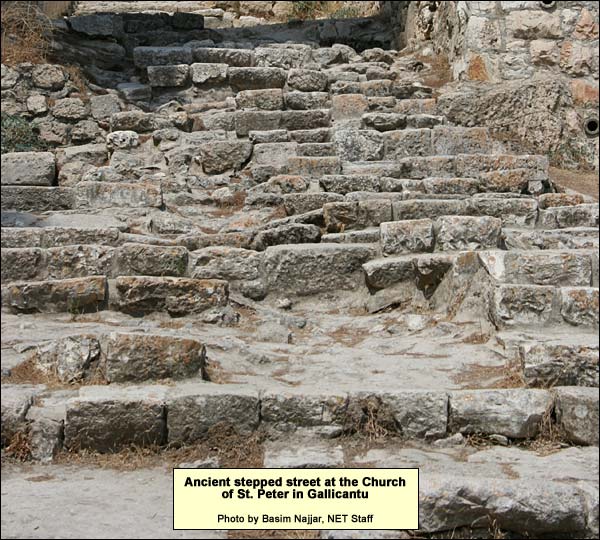
3. Just below the parking lot is a platform: it is the best place to study the original Jerusalem from the west. The Egyptian Execration TextsExecration texts: The Egyptians wrote the names of their enemies on clay figures, which they then smashed or maltreated, hoping that a similar fate would befall those designated. and the Amarna lettersIn 1887 a peasant woman at el-Amarna in Egypt discovered 379 clay tablets in the ruins of the Pharaoh Ikhnaton's palace. These included letters in Akkadian from princes of city-states in the land of the Bible, such as Megiddo and Jerusalem, as well as some from Babylonia and Assyria. Written in the 14th century BC, they convey an impression of unstable conditions in the land at that time. show that the city was important even before David made it his capital. From our present vantage point we can understand why. On the one hand, it's attached to the southern edge of the sole plateau on the central range (the Benjamin Plateau), giving it good agricultural land as well as access to major roads.
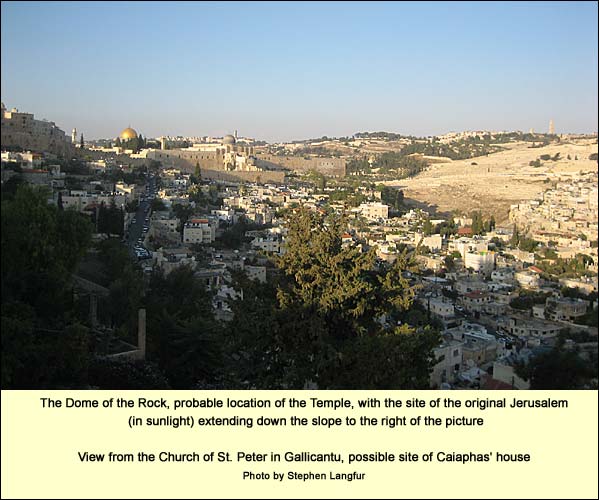
Yet several cities also enjoyed the Benjamin plateau: Gibeon, Gibeah, Rama, Mizpeh, Beeroth, Bethel. What distinguished Jerusalem from these competitors was the depth of its defending valleys, which we can appreciate from here. We can find the meeting point of the Kidron (once 60 feet deeper) with the Hinnom. The western valley of David's city (later called the Tyropoeon or "Cheesemakers'") is harder to make out, because much of it has filled with garbage through the millennia. At the junction of valleys is a Greek Orthodox monastery (1874) dedicated to an Egyptian hermit, St. Onuphrius, who lived in a cave nearby. Onuphrius went naked, yet he was able to preserve his modesty thanks to a long and ample beard. (One may see a Crusader depiction on a column in Bethlehem's Church of the Nativity.) West of Onuphrius' monastery is a charnel house of the Hospitalers, who conducted an average of 50 burials daily. They built it over ancient graves. (Murphy-O'ConnorMurphy-O'Connor, Jerome. The Holy Land: An Archaeological Guide, 4th edition. London: Oxford, 1998., p. 119). Eusebius identified this area as Potter's Field, where Judas hung himself (Acts 1: 18-19). Thus it gained the name of Akeldama, the "field of blood." Hours for the Church of St. Peter in Gallicantu: 08:30-17:00, closed Sundays. Wear modest dressShoulders covered, legs covered below the knees..
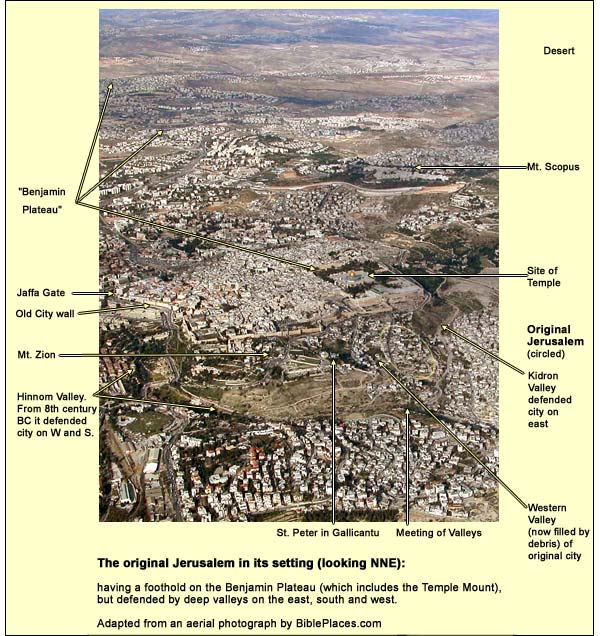


{mospagebreak title=The Upper Room } The Upper Room During the three pilgrimage festivals (Passover, Pentecost and Tabernacles), Jews flocked to Jerusalem. No one knows how many: even today, with aerial photography, it is hard to estimate the size of a crowd. Few accept Josephus'Josephus Flavius (36 – 100 AD), Jewish general, one of two directing the revolt against Rome in Galilee. After Vespasian captured him, he prophesied the latter would be emperor. When this proved true, the Romans honored him. He then turned historian, writing The Jewish War, The Antiquities of the Jews and many other books. Because of a paragraph about John the Baptist (and maybe a sentence about Jesus), the Church preserved his works. figure of 2,700,000 at one Passover (WarWar= Josephus Flavius. The Jewish War. Translated by William Whiston. (Abbreviated in text as War.) VI 9.3). The esplanades of the al-Aqsa Mosque and the Dome of the Rock, which most scholars identify with the courts of Herod's Temple, can hold 400,000. That figure is probably close to the ancient reality. But whether one chooses the larger or smaller number, it is clear that during these festivals Jerusalem experienced a huge "tourism boom." Where would all the pilgrims have stayed? Many would have received hospitality in the homes of Jerusalemites, who made guest rooms available for this purpose. Homeowners were prohibited from taking rent from pilgrims because the homes in Jerusalem "belong to the tribes," although the pilgrims would have felt a social obligation (not legally binding) to give gifts in return. More. (Those who could not find accommodation in the city would have stayed in tents outside, as Josephus indicates in AntiquitiesAntiquities = Josephus Flavius. Antiquities of the Jews. Translated by William Whiston. (Abbreviated in text as Antiquities.) XVII 9.3.)

During Jesus' pilgrimage to Jerusalem at Passover, he made use of such a guest room. In Luke 22:10-12, Jesus tells Peter and John to follow a man carrying a jar of water, and when he enters a house, to tell the owner, "The Teacher says to you, 'Where is the guest room, where I may eat the Passover with my disciples?' cj(22,12); He will show you a large, furnished upper room. Make preparations there." Such a room is also mentioned in Acts 1:12. After Jesus' ascension from the Mt. of Olives, the disciples went back into the city, to "the upper room where they were staying." They were still in Jerusalem fifty days after Passover for the Feast of Weeks (or Pentecost, seven weeks after Passover, on the 50th day). At this time they were ... ...all with one accord in one place. cb(2,2); Suddenly there came from the sky a sound like the rushing of a mighty wind, and it filled all the house where they were sitting. cb(2,3); Tongues like fire appeared and were distributed to them, and one sat on each of them. cb(2,4); They were all filled with the Holy Spirit, and began to speak with other languages, as the Spirit gave them the ability to speak. cb(2,5); (Acts 2:1-4) Both these events relate to the history of ancient Israel. The Lord's Supper: According to the first three ("synoptic") Gospels, this meal was a Passover Seder. And what was Passover at that time? The festival had both an agricultural and a historical significance. (As did the Feast of TabernaclesThe Feast of Tabernacles marked the autumn harvest (of figs, dates, olives, pomegranates and grapes), when people lives in booths to guard the ripe fruits from thieves and thirsty animals. Leviticus 23:42 also gave the festival historical significance: "You shall dwell in booths seven days. All who are native-born in Israel shall dwell in booths, that your generations may know that I made the children of Israel to dwell in booths, when I brought them out of the land of Egypt. I am Yahweh your God.".) Agriculturally, Passover marked the barley harvest. Historically, the Book of Exodus (12:14) calls it a festival of remembrance, on which the children of Israel remember how God delivered them from slavery in Egypt. Jesus broke bread, in our earliest account (I Corinthians 11:24-25), saying, “Take, eat. This is my body, which is broken for you. Do this in memory of me.” cb(11,25); In the same way he also took the cup, after supper, saying, “This cup is the new covenant in my blood. Do this, as often as you drink, in memory of me.” cb(11,26); He presents himself as the fulfillment of the redemption that began with the exodus from Egypt. The Feast of Weeks or Pentecost corresponds to the wheat harvest, but the First Testament does not connect it to a historical event. The ancient Rabbis did so, however, linking it to the giving of the Torah at Mt. Sinai. Here, then, we also find a fulfillment: the giving of the Holy Spirit occurs on the anniversary of the giving of the Torah.

The Upper Room that we visit today on Mt. Zion has no resemblance to a room of 2000 years ago. The area has gone through a difficult history. The present design is basically Franciscan, from the 14th century - but with a Muslim mihrabMihrab: a niche or depression in a wall, e.g. of a mosque, indicating the kibla: the direction toward Mecca, for the purpose of Muslim prayer., added in the 16th after an Ottoman sultan ordered the "infidels" out. (The Israelis took over in 1948 and have held the hill ever since. The site is under their jurisdiction.) Is this, despite the Gothic appearance, the place of the events that we remember here? The case is stronger for Pentecost. Writing in the 4th century, Bishop Epiphanius of Salamis describes a visit by HadrianPublius Aelius Hadrianus (76 – 138 AD). Roman emperor from 117 until his death. He quelled the Bar Kokhba revolt, the second major Jewish uprising in the land. After banishing the Jews from Jerusalem, he rebuilt the city, naming it Aelia Capitolina. He is also remembered as the builder of Hadrian's Wall in northern England. to Jerusalem more than 200 years before his time. The emperor, he says, surveyed the city, which still lay in ruins from the destruction by Titus in 70 AD. And Hadrian found the temple of God trodden down and the whole city devastated, save for a few houses and the very small church of God, where the disciples, when they had returned after the Savior had ascended from the Mount of Olives, went to the upper room. For there it had been built, that is, in that portion of Zion that escaped destruction, together with blocks of houses in the neighborhood of Zion and the seven synagogues that alone remained standing in Zion, like solitary huts. (On Weights and Measures, 14-15) By the time Epiphanius wrote, the term "Zion" was confined to Jerusalem's western hill (see Mt. Zion). In 348 one Cyril, later to become bishop of Jerusalem, delivered a sermon referring to the place "where the Pentecost Spirit descended upon the apostles, namely in the Upper Church of the Apostles." Was this the same "small church of God" in Zion referred to by Epiphanius? Apparently so, for later in the 4th century a bishop named John refers to... the dedication of the Holy and Glorious Zion, which is the mother of all churches, that had been founded by the Apostles, which Emperor Theodosius the Great (379-395) has built, enlarged, and glorified, and in which the Holy Spirit had come down on the holy day of Pentecost. (van EsbroeckVan Esbroeck, Michel. Les plus anciens homiliaires Georgiens. Louvain, Belgium: 1975., 314-315.) When EgeriaName uncertain. A nun from the Atlantic coast, perhaps Spain, who visited the Holy Land in the late 4th century and described her journey in Latin for the sisters at home. She had a special interest in churches and Christian ritual. Only the middle of her Travels has survived, but it is a unique and valuable source. describes the Jerusalem liturgy (ca. 394 AD), she mentions that the Sunday morning service is held in the large church built by Constantine in Golgotha (today the Holy Sepulcher - SL), "that is, behind the Cross, on every Lord's Day throughout the year except on the one Sunday of Pentecost, when they proceed to Zion." (My emphasis - SL.) There is a strong tradition, then, at least from the 4th century, maybe from the 2nd, and even perhaps from the time of the event itself, connecting a place on Mt. Zion with the gift of the Holy Spirit on Pentecost. There is no 4th-century tradition, however, connecting the same place with Jesus' Passover meal. According to EgeriaFrom the letters of Egeria, a nun of the 4th-century, describing her pilgrimage to the Holy Land. (The "Anastasis" was the Church of the Resurrection with the empty tomb at its center.) XXXV On the fifth weekday everything that is customary is done from the first cockcrow until morning at the Anastasis, and also at the third and at the sixth hours. But at the eighth hour all the people gather together at the martyrium according to custom, only earlier than on other days, because the dismissal must be made sooner. Then, when the people are gathered together, all that should be done is done, and the oblation is made on that day at the martyrium, the dismissal taking place about the tenth hour. But before the dismissal is made there, the archdeacon raises his voice and says: "Let us all assemble at the first hour of the night in the church which is in Eleona, for great toil awaits us to-day, in this very night." 2. Then, after the dismissal at the martyrium, they arrive behind the Cross, where only one hymn is said and prayer is made, and the bishop offers the oblation there, and all communicate. Nor is the oblation ever offered behind the Cross on any day throughout the year, except on this one day. And after the dismissal there they go to the Anastasis, where prayer is made, the catechumens and the faithful are blessed according to custom, and the dismissal is made., that meal was remembered on Maundy Thursday "behind the Cross" at Constantine's Church of the Resurrection. Thus the 4th-century Christians, despite their interest in identifying biblical sites, did not have a traditional place for the Lord's supper, as they did for Pentecost. Since both events occurred in upper rooms, however, the one on Mt. Zion attracted the memory of the Lord's supper a century later. With one or both of these traditions at their backs, the Byzantines built a grand church called Holy Zion (Hagia Zion), which appears on the 6th-century Madaba map. It is unclear whether it incorporated the older Church of the Apostles.


A liturgical celebration in the Church of Holy Zion focused on King David and the Apostle James (founders, respectively, of the Jewish and Christian communities in Jerusalem). This service gave rise to the belief that both were buried on the hill. (O'ConnorMurphy-O'Connor, Jerome. The Holy Land: An Archaeological Guide, 4th edition. London: Oxford, 1998., p. 105.) Accordingly, the traditional tomb of James is today found in the Armenian cathedral just north of the Old City wall. (See St. James Cathedral in the photo on the right.) The tomb of David is located in a chamber below the Upper Room. The Book of Kings (1 Kings 2:10) has David buried within his city, which was on the spur just south of the Temple Mount. But the Byzantines didn't know where David's Jerusalem was. Misled by the name Zion, which had shifted to this western hill, they assumed his grave was here.

When the Persian army invaded the Byzantine Empire in 614, it destroyed most of the land's churches, including Holy Zion. After the Persian withdrawal, the Christians rebuilt it, but in the early 11th century al-HakimAl-Hakim (996-1021). Fatimid Caliph who ruled the Muslim world from Egypt, waging a relentless campaign to convert his Christian and Jewish subjects to Islam. In 1016, convinced of his own divinity, he led his followers out of Islam into a new religion, whose members are known as Druze. He disappeared in Cairo in 1021. Non-Druze believe he was murdered. Druze believe he went into hiding and will return to redeem and rule the world. battered it down. Within the southern section of the ruins, the Crusaders built a church they called St. Mary of Mt. Zion: they had a tradition that after Jesus' resurrection, the Virgin had lived on this hill until her death (today remembered in the nearby Dormition Abbey). The Crusader church incorporated today's Upper Room (the north wall includes Crusader columns). With implicit reference to the Lord's Supper, a Crusader capital reflects the belief that the pelican, if unable to find food for her young, offers them flesh from her breast. Logistics: Open from 8 a.m. to 5 p.m., but Friday only to 1 p.m. {mospagebreak title=Peter in Gallicantu} St. Peter in Gallicantu: The House of Caiaphas?

In the 4th century AD, Christians were first allowed to build churches. In some cases they may have had a continuous tradition about a particular place, and then we should expect to find the ruins of a 4th-century church. There were such, for example, at Capernaum, Tabgha, Kursi, Bethlehem, Mamre, on the Mt. of Olives and in Jerusalem. Where the ruins do not go back that far, their absence may indicate that in the obscure centuries, the 1st through the 4th, Christians had no strong tradition connecting an event to the place. At St. Peter in Gallicantu on Mt. Zion, there are 1st-century ruins, but Christians did not build a church here till the 6th. The first literary reference stems from an 8th-century monk (a later Epiphanius): "To the right, outside the city and near the wall, is a church, where Peter, when he went out, bitterly wept." Nevertheless, there are three good reasons to come here: 1. Whether or not this was the site of Caiaphas' house, the place certainly helps one to get the feeling of what it must have been like to be imprisoned overnight. Beneath the church are two intriguing chambers hewn into bedrock. The larger one may have been a storeroom: some of the holes in the stones could have been for hanging sacks of grain. Yet they could also have been for chaining prisoners.

On the south side of this room is a narrow aisle with a single step, on which a guard could stand to look through a small window into a deeper chamber, where a prisoner might be kept. Today we enter this deeper chamber through a recent breach. Standing in it and looking up (as in the photo, right), we see two openings, above which is a divided staircase. No doubt this staircase reached the bottom of the chamber at a time when the floor was higher. Perhaps this was a Jewish ritual bath. It could have been deepened to form a high-security cell. A hole directly above resembles the opening of a cistern. In memory of the night he spent under arrest, we may here read Psalm 88. 2. Outside the church, a few yards to the north, is an ancient stepped street. It may have been here at the time of Jesus' trial.

3. Just below the parking lot is a platform: it is the best place to study the original Jerusalem from the west. The Egyptian Execration TextsExecration texts: The Egyptians wrote the names of their enemies on clay figures, which they then smashed or maltreated, hoping that a similar fate would befall those designated. and the Amarna lettersIn 1887 a peasant woman at el-Amarna in Egypt discovered 379 clay tablets in the ruins of the Pharaoh Ikhnaton's palace. These included letters in Akkadian from princes of city-states in the land of the Bible, such as Megiddo and Jerusalem, as well as some from Babylonia and Assyria. Written in the 14th century BC, they convey an impression of unstable conditions in the land at that time. show that the city was important even before David made it his capital. From our present vantage point we can understand why. On the one hand, it's attached to the southern edge of the sole plateau on the central range (the Benjamin Plateau), giving it good agricultural land as well as access to major roads.

Yet several cities also enjoyed the Benjamin plateau: Gibeon, Gibeah, Rama, Mizpeh, Beeroth, Bethel. What distinguished Jerusalem from these competitors was the depth of its defending valleys, which we can appreciate from here. We can find the meeting point of the Kidron (once 60 feet deeper) with the Hinnom. The western valley of David's city (later called the Tyropoeon or "Cheesemakers'") is harder to make out, because much of it has filled with garbage through the millennia. At the junction of valleys is a Greek Orthodox monastery (1874) dedicated to an Egyptian hermit, St. Onuphrius, who lived in a cave nearby. Onuphrius went naked, yet he was able to preserve his modesty thanks to a long and ample beard. (One may see a Crusader depiction on a column in Bethlehem's Church of the Nativity.) West of Onuphrius' monastery is a charnel house of the Hospitalers, who conducted an average of 50 burials daily. They built it over ancient graves. (Murphy-O'ConnorMurphy-O'Connor, Jerome. The Holy Land: An Archaeological Guide, 4th edition. London: Oxford, 1998., p. 119). Eusebius identified this area as Potter's Field, where Judas hung himself (Acts 1: 18-19). Thus it gained the name of Akeldama, the "field of blood." Hours for the Church of St. Peter in Gallicantu: 08:30-17:00, closed Sundays. Wear modest dressShoulders covered, legs covered below the knees..
